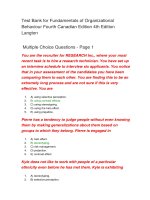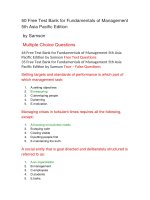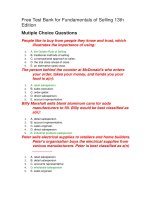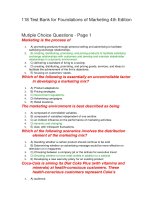Test bank for fundamentals of nursing 4th edition delaune
Bạn đang xem bản rút gọn của tài liệu. Xem và tải ngay bản đầy đủ của tài liệu tại đây (19.73 KB, 5 trang )
CHAPTER 1: EVOLUTION OF NURSING AND NURSING EDUCATION
MULTIPLE CHOICE
1. The nurse realizes that the primary focus of nursing is on the:
a. illness.
c. treatment of the illness.
b. cause of the illness.
d. client’s response to the illness.
ANS: D
Nursing requires a delicate balance of promoting clients’ independence and dependence. Nursing focuses not on illnesstbu
rather on the client’s
response to illness. The practice of physicians or medicine focuses on the cause of the illness and the treatment of the
illness.
PTS: 1
DIF: Analysis
REF: Introduction
2. While studying the history of nursing, the nurse realizes that the first hospital in the West was established by:
a. Fabiola.
c. Florence Nightingale.
b. Hygiea.
d. Dorothea Dix.
ANS: A
Fabiola founded the first hospital in 390 AD. Hygiea was the goddess of health according to the ancient Greeks. Florence
Nightingale is
considered the founder of modern nursing, and she lived from 1820 to 1910. Dorothea Dix practiced nursing during the Civ
il War.
PTS: 1
DIF: Analysis
REF: Table 1-1| Evolution of Nursing
3. The nurse realizes that religion affected the development of nursing which began:
a. in India around 800-600 BC.
c. during the Middle Ages.
b. during the Roman Empire.
d. at the time of the Renaissance.
ANS: A
The strong influence of religions on the development of nursing started in India between 800 to 600 BC. The crusades of
the Middle Ages and the
Renaissance occurred after 600 BC. There is no documentation of religious influences on the development of nursing durin
g the Roman Empire.
PTS: 1
DIF: Analysis
REF: Religious Influences
4. Reflecting on the impact of wars on the evolution of nursing, the nurse realizes that:
a. the need for nurses increased during and after major wars.
b. poor conditions during wars caused a decline in nursing care.
c. wars have been the stimulus for most nursing advances.
d. wars have had little effect on the evolution of nursing.
ANS: A
During wartime, the need for nurses increases dramatically, both at home and in the field. Poor conditions during warsidd not cause a decline in
nursing care. Wars may or may not have been the stimulus for nursing advances; however, wars have effected the evolution
of nursing care.
PTS: 1
DIF: Analysis
REF: Demands of War
5. The nurse realizes that which of the following is a belief that Florence Nightingale had about nursing education?
a. Basing education on a holistic framework inclusive of illness and health
b. Needing a practical basis for nursing practice
c. Creating an environment that serves physicians is most important
d. Basing the nursing curriculum on medical knowledge
ANS: A
Florence Nightingale had specific beliefs about nursing education. The first is that it is based upon a holistic framewo
rk inclusive of illness and
health. Nightingale also believed that there is a need for a theoretical basis for nursing practice and not a practicalbasis. She also believed in the
importance of creating an environment that promotes healing and not an environment that served physicians. One additiona
l belief was that the
nursing curriculum should be based upon nursing knowledge and not medical knowledge.
PTS: 1
DIF: Analysis
REF: Florence Nightingale (1820 - 1910)
6. The nurse realizes that the Nightingale Training School of Nurses at St. Thomas’s Hospital in London was:
a. the first school of nursing in the West.
b. the first nursing school to provide both theory-based knowledge and clinical skill building.
c. the first school of nursing to accept women.
d. established to provide nurses to fight in the Crimean War.
ANS: B
The Nightingale Training School of Nurses at St. Thomas’s Hospital in London was the first school for nurses that provid
ed both theory-based
knowledge and clinical skills. This was not the first school of nursing in the West nor the first school of nursing toccept
a women. This school
was not established to provide nurses to fight in the Crimean War.
PTS: 1
DIF: Analysis
REF: Florence Nightingale (1820 - 1910)
1
Full file at />
7. The nurse, considering home care nursing, realizes that Lillian Wald is noted as being:
a. the first nurse to graduate from a school of nursing in the United States
b. Superintendent of Nurses during the Civil War.
c. the first community health nurse.
d. the founder of the American Nurses Association.
ANS: C
Lillian Wald spent her life providing nursing care to the indigent and, in 1893, as the first community health nurse, eshfounded public health
nursing with the establishment of the Henry Street Settlement Service. Wald was not the first nurse to graduate from achool
s
of nursing in the
United States nor was she the Superintendent of Nurses during the Civil War. She was not the founder of the American Nur
ses Association.
PTS: 1
DIF: Analysis
REF: Nursing Pioneers and Leaders: Lillian Wald
8. The nurse, giving direction to a nursing assistant for client care, realizes that which of the following nurse leaderspposed
o
the movement to put
untrained nursing aides under the control of physicians during World War I?
a. Clara Barton
c. Annie Goodrich
b. Isabel Hampton Robb
d. Jane Delano
ANS: D
During World War I, Delano was opposed to the aide education plan created by physicians who wanted the Red Cross to put
untrained nursing
aides at their sides to assist with war casualties. Annie Goodrich was in favor of the physicians’ aide education plan.
Robb was a supporter of the
rights of nursing students. Clara Barton was a nurse during the Civil War.
PTS: 1
DIF: Analysis
REF: Nursing Pioneers and Leaders
9. The nurse, assisting nursing students with providing client care, realizes that Isabel Hampton Robb is noted for whichfothe following?
a. Opposing the organization of nurses
b. Establishing the American Red Cross
c. Believing that the nursing student was a learner, not an employee
d. Establishing the Frontier Nursing Service
ANS: C
Isabel Hampton Robb was an early supporter of the rights of nursing students and emphasized the role of the nursing stud
ent as a learner instead
of an employee. Robb did not oppose the organization of nurses since she founded several nursing organizations. Robb did
not establish the
American Red Cross nor did she establish the Frontier Nursing Service.
PTS: 1
DIF: Analysis
REF: Nursing Pioneers and Leaders
10. While researching a client health care issue, the nurse realizes that the nurse who wrote one of the first nursing textb
ooks was:
a. Lavinia Dock.
b. Mary Breckinridge.
c. Martha Franklin.
d. Amelia Greenwald.
ANS: A
Lavinia Dock was an influential leader in American nursing education; she wrote one of the first nursing textbooks as we
ll as being the first editor
of the American Journal of Nursing. Mary Breckinridge created the Frontier Nursing Service. Martha Franklin advocated for racial equality in
nursing. Amelia Greenwald was a catalyst for international public health nursing.
PTS: 1
DIF: Analysis
REF: Nursing Pioneers and Leaders
11. While documenting in a client’s record, the nurse remembers that the nurse leader who introduced the practice of keeping
nurses’ notes was:
a. Mamie Hale.
c. Harriet Neuton Phillips.
b. Mary Mahoney.
d. Linda Richards.
ANS: D
Linda Richards introduced the practice of keeping nurses’ notes and physicians’ orders as part of medical records. Mamie
Hale upgraded the
educational programs for midwives. Mary Mahoney was America’s first African American professional nurse. Harriet Neuton
Phillips was the
first American nurse to receive a training certificate.
PTS: 1
DIF: Analysis
REF: Nursing Pioneers and Leaders
12. While reviewing a client’s health insurance plan, the nurse remembers that the first prepaid medical plan was started :in
a. Pacific Northwest lumber and mining camps.
b. Chicago.
c. New York City.
d. Washington DC.
ANS: A
Prepaid medical plans were started in Pacific Northwest lumber and mining camps where employers contracted for and paid
a monthly fee for
medical services. This led to the establishment of the Bureau of Medical Services. Prepaid medical plans were not starte
d in Chicago, New York
City, nor Washington, DC.
PTS: 1
DIF: Application
REF: Nursing in the 20th Century
2
Full file at />
13. A client tells the nurse that he lived through the Great Depression and remembers when which of the following occurred?
a. The first hospital created in the West
b. The establishment of the Red Cross
c. A school of nursing established by Florence Nightingale in London
d. The growth of health insurance plans
ANS: D
The Depression provided the main impetus for the growth of insurance plans. The first hospital was created in 390 AD. Th
e Red Cross was
established during the Civil War. Florence Nightingale started a school of nursing in London in the 1800s.
PTS: 1
DIF: Application
REF: Nursing in the 20th Century
14. The nurse is reading about the federal government’s plans for health insurance and realizes that the first health insura
nce was:
a. Blue Shield.
c. Social Security.
b. Blue Cross.
d. benefits for veterans.
ANS: B
In 1920, American hospitals offered a prepaid hospital plan that led to the “Baylor Plan,” which eventually became therototype
p
of Blue Cross.
Blue Shield was developed by the American Medical Association to provide reimbursement for medical services providedsubscribers.
to
Social
Security started in 1935. Benefits for veterans began during World War II.
PTS: 1
DIF: Analysis
REF: Nursing in the 20th Century
15. The nurse is providing care to a client according to a protocol. Protocols were established:
a. during the Civil War.
b. after the Crimean War.
c. in 1912 by the Chicago Visiting Nurses Association.
d. in 1933 by the American Hospital Association.
ANS: C
In 1912, the Chicago Visiting Nurses Association developed a list of standing orders for nurses to follow in providingome
h care. These orders
were the groundwork for nursing protocols. Nursing protocols were not established during the Civil War or after the Crim
ean War. The American
Hospital Association endorsed Blue Cross in 1933.
PTS: 1
DIF: Application
REF: Nursing in the 20th Century
16. The nurse is asked why she attended a university for nursing education. Which of the following reports would provide the
most information
regarding the university setting for nursing education?
a. The Institute of Research and Service in Nursing Education report
b. The Goldmark Report
c. The Brown Report
d. The Flexner Report
ANS: B
The Goldmark Report, published in 1923, concluded that for nursing to be on equal footing with other disciplines, nursin
g education should occur
in the university setting. The Institute of Research and Service in Nursing Education report served to increase the numb
er of practical nursing
schools in the United States to increase the supply of nurses. The Brown Report identified problems in diploma education
and strengthened the
argument provided by the Goldmark Report. The Flexner Report identified inadequacies in medical schools.
PTS: 1
DIF: Application
REF: Nursing in the 20th Century
17. The nurse is providing care to a client after collaborating with the client’s physician. The agency that identified the
need for nurses to work in
collaboration with physicians was the:
a. National Commission on Nursing.
c. Secretary’s Commission on Nursing.
b. Institute of Medicine.
d. Pew Health Professions Commission.
ANS: A
The National Commission on Nursing, established in 1980, studied nursing education and related issues in hospital manage
ment. As a result of
the commission, attention was given to the need for physicians and nurses to enter into collaborative practice. The Inst
itute of Medicine focused
on the need for federal funding for nursing education. The Secretary’s Commission on Nursing focused on nursing compensa
tion, health care
financing, and nurse decision making. The Pew Health Professions Commission created competencies to address the needs clients.
of
PTS: 1
DIF: Application
REF: Nursing in the 20th Century
18. The nurse attended nursing school during the early 1980s when there was an identified need for nurses. The one factor at
thcaused the increased
need for nurses during this time was:
a. evolving technology.
c. care for the homeless.
b. aging population.
d. proliferation of HMOs.
ANS: D
During the 1980s, there was a proliferation of HMOs, which was one factor that led to an increased need for nurses. It w
as during the 1990s that
evolving technology, the aging population, and care for the homeless were issues for nurses.
PTS: 1
DIF: Analysis
REF: Social Forces Affecting Nursing
3
Full file at />
19. The student nurse in a bachelor’s degree program to become a registered nurse will need to do which of the following bef
ore being able to provide
client care?
a. Write the CNATS examination
c. Write the NCLEX-RN examination
b. Write the NCLEX-PN examination
d. Provide evidence of credentials
ANS: C
Graduates of registered nurse programs write the NCLEX for registered nurses, or NCLEX-RN, examination. Graduates of aicensed
l
practical
or vocational program write the NLCEX for practical nurses, or NCLEX-PN, examination. Advanced practice registered nurse
s may need to
provide credentials to practice, depending upon the state of residence. The CNATS examination is the licensing examinati
on in Canada.
PTS: 1
DIF: Application
REF: Nursing Education Overview
20. The college student is attending an accredited nursing program at a local university. The regulatory body responsible rfoaccrediting nursing
programs in the United States is:
a. CAUSN.
c. AACN.
b. NLNAC.
d. ANA.
ANS: B
The National League for Nursing Accrediting Commission, or NLNAC, accredits nursing programs in the United States. The anadian
C
Association of University Schools of Nursing, or CAUSN, accredits baccalaureate programs in Canada. The AACN, or America
n Association of
Colleges of Nursing, evaluates the quality and integrity of baccalaureate and graduate degree nursing education programs
. The American Nurses
Association, or ANA, does not accredit nursing education programs.
PTS: 1
DIF: Analysis
REF: Nursing Education Overview
21. The nurse attended a diploma program to become a registered nurse. In this program, the primary emphasis of education wa
s to prepare the nurse
to be:
a. technically competent.
c. professionally prepared.
b. clinically competent.
d. a leader for education and research.
ANS: B
The diploma program prepares the nurse to be clinically competent to plan, direct, and implement care for clients. Thessociate
a
degree program
prepares the nurse to be technically competent to plan and implement care. The baccalaureate program prepares the nurse
to be professionally
prepared to plan, implement, and coordinate care of clients. The doctoral program prepares the nurse to be a leader foreducation and research.
PTS: 1
DIF: Analysis
REF: Table 1-2 Educational Programs
22. A high school graduate wants to practice nursing in the hopes of entering the field of nursing research. The educational
program that would best
fit this graduate’s needs would be:
a. diploma education.
c. associate degree education.
b. baccalaureate education.
d. licensed vocational education.
ANS: B
The emphasis in baccalaureate education is on critical decision-making skills, independent nursing judgment, and acquiri
ng professional values
and research skills. The emphasis in diploma education is to provide clinically competent care to clients. The emphasis
in associate degree
education is to acquire professional behaviors, communication and assessment skills, teaching, collaborating, and managi
ng care. The graduate
would not be educationally prepared to enter the field of nursing research if attending a licensed vocational nursing ucation
ed
program.
PTS: 1
DIF: Application
REF: Nursing Education Overview
23. A physical therapist wants to become a nurse and provide care to clients with neurological and musculoskeletal disorders
. One way for the
therapist to achieve this goal would be to attend:
a. a nontraditional graduate program leading to RN licensure.
b. a diploma program of nursing.
c. an associate degree program of nursing.
d. a baccalaureate degree program of nursing.
ANS: A
The nontraditional graduate program of nursing leading to RN licensure would prepare the therapist to write the NCLEX-RN
examination. These
types of programs were created to admit individuals, other than BSN graduates, to nursing programs and become registered
nurses. The other
choices are considered basic nursing education and, even though the therapist would be able to write the NCLEX-RN examin
ation, they would
not support the therapist’s desire to become an advanced practice nurse.
PTS: 1
DIF: Application
REF: Master's Programs
24. The nurse is attending an educational program provided by the hospital’s nurse educator. The purpose of this educational
program would be to:
a. expand the nurse’s basic knowledge.
b. reinforce learning obtained in nursing school.
c. assist the nurse to achieve the goals of the employer.
d. support the nurse by increasing skills to fulfill assigned responsibilities.
ANS: C
The nurse is attending a staff development program with the purpose of assisting the nurse to achieve the goals of themployer.
e
Staff
development programs do not expand the nurse’s basic knowledge nor reinforce learning obtained in nursing school. In-ser
vice education supports
the nurse by increasing skills to fulfill assigned responsibilities.
PTS: 1
DIF: Analysis
REF: Staff Development and Continuing Education
4
Full file at />
25. The nurse, a new employee of a hospital, will be scheduled to attend which of the following?
a. Staff development classes
c. Continuing education courses
b. In-service classes
d. Orientation
ANS: D
Orientation sessions typically occur at the initiation of employment, and they are an important organizational tool for
recruitment and retention.
Staff development classes would occur after attending orientation. In-service classes would occur after orientation. Con
tinuing education courses
may or may not be sponsored by the hospital and are often used to determine continuing competency.
PTS: 1
DIF: Application
REF: Staff Development and Continuing Education
26. The nurse is attending a continuing education program. The purpose of this program would be to:
a. assist the nurse to achieve the goals of the employer.
b. increase skills to fulfill assigned responsibilities.
c. expand upon basic nursing education.
d. improve the nurse’s ability to be flexible, factual, futuristic, and functional.
ANS: D
Continuing education improves the ability of the nurse to be flexible, factual, futuristic, and functional. Staff develo
pment assists the nurse to
achieve the goals of the employer. In-service classes help increase the nurse’s skills to fulfill assigned responsibilit
ies. Continuing education
programs may or may not expand upon the nurse’s basic education.
PTS: 1
DIF: Analysis
REF: Staff Development and Continuing Education
27. According to the differentiated nursing practice philosophy, if a high school graduate wants to become a nurse to provid
e care to clients in the
community, the level of nursing education needed would be a(n):
a. associate degree.
c. bachelor’s degree in nursing.
b. diploma.
d. master’s degree in nursing.
ANS: C
According to the PEW Health Professions Commission, associate degree programs would be appropriate for the entry-levelospital-based
h
setting
and nursing home. The bachelor’s degree in nursing would be appropriate for hospital-based care management and community
-based practice.
The master’s degree program prepares the nurse for specialty practice in the hospital and independent practice as a prim
ary provider. The
diploma program is not identified within the differentiated nursing practice philosophy.
PTS: 1
DIF: Application
REF: Differentiated Practice
28. The nurse realizes that there is a need for an additional one million nurses by the year 2010. One way to meet this need
would be for individuals
desiring to become nurses to attend which of the following?
a. Diploma program for nursing
c. Associated degree program for nursing
b. Bachelor’s degree program for nursing
d. Accelerated degree program
ANS: D
An accelerated degree program for non-nursing students is one innovative educational approach to meet the projected need
for a million additional
nurses by the year 2010. Neither the diploma program, bachelor’s degree program, nor associated degree program would ful
fill the need for an
additional one million nurses by the year 2010.
PTS: 1
DIF: Analysis
REF: Accelerated Degree Programs
29. The nursing student is reviewing practice routines to promote critical thinking skills. The student is most likely using
which of the following?
a. Staff development program
c. Electronic mail
b. In-service lecture
d. Computer-assisted instruction
ANS: D
Computer-assisted instruction augments classroom lectures and presentations in the form of interactive and linear video
programs, client
simulations, and drill and practice routines to promote problem solving, critical thinking, and clinical skills. A staff
development program will not
provide practice routines to promote critical thinking skills. An in-service lecture will not provide practice routines
to promote critical thinking
skills. Electronic mail will not promote critical thinking skills or practice routines.
PTS: 1
DIF: Application
REF: Technology Changes in Nursing Education
30. The nursing student is attending a client care experience in the community. This type of experience is considered:
a. service learning.
c. continuing education.
b. staff development.
d. computer-assisted instruction.
ANS: A
Service learning is an educational method that uses community services with explicit learning objectives, preparation,nda intentional reflective
activities. Service learning is experimental in nature, allows students to engage in activities that address communityeeds,
n incorporates reflection,
and embraces the concept of reciprocity between the learner and the person being served. The other choices do not focus
on client care in the
community.
PTS: 1
DIF: Analysis
REF: Service Learning
5
Full file at />









